Fondren Library:
A Brief History
The First Chapter:
1913-1945
One year after Rice opened, the library appeared in the second floor of what is now
Lovett Hall. Initially it was a diminutive institution: the "library" was actually just 200
volumes, enough to fill only one of the bookcases in the room. Edgar Odell Lovett, Rice's
first president, said that the library would only house materials that were necessary
supplements to courses or that could aid advanced students and faculty in their study.
He also made it clear that in order to avoid any redundancy with the collection of the
Houston Public Library, technical and scientific works would be the main publications
purchased. Ms. Alice Cromwell Dean, a math student at Rice with no previous
professional library experience, carefully worked on expanding the collection through its
first years. She was named Acting Librarian by President Lovett, and she
made many of the critical policy decisions for the library, some of which
still have an impact today. For example, it was her decision to use the
Library of Congress cataloging system, which is still in place.
For the next thirty years, virtually the only thing that changed
about the library was its size; predictably (and desirably), it got much larger.
The room in the administration building was soon filled and the collection
spilled onto the first floor, then into the basement. After this, it
relocated parts of itself to small satellite libraries around campus. By 1945,
the collection had swelled to 200,000 volumes and was scattered between
nine different locations.
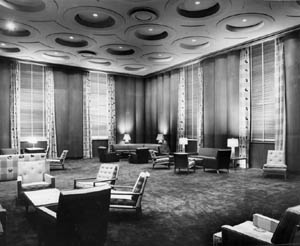
| |
Lecture Lounge (later the Kyle Morrow Room)
|
|
A Change in Setting:
1945-1968
In 1945, the Trustees of the Rice Institute developed a long-range plan for
the university. One of the major stipulations of the plan was the building of a
permanent library facility on the opposite end of the academic quad. The trustees
contacted the local architecture firm of Staub & Rather, who drew up initial plans
and estimated the cost of the new building to be $1 million. At this point, Fondren
received its name through the enormous generosity of Ella F. Fondren. Mrs. Fondren
was the widow of an oilman from Humble, W. W. Fondren, and she specifically requested
her donation be used for the construction of the library in memory of her late husband.
The university was only too happy to comply. The cornerstone was laid in December of
1947, and construction proceeded over the next year and a half. Finally, during the
homecoming celebrations of 1949, the new Fondren Library was
unveiled.
|
|
Most of Fondren looked much the same as it does today, but there were a few
major differences, particularly on the first floor. The lobby area was the most
noticeable of these: the entrance space was very open and lined with marble. On one
side were the cabinets containing the card catalog, and large double glass doors on
opposite walls led to the liberal arts and engineering reading rooms. The general
opinion of the building at the time was that the modern openness and clean lighting
complemented the rest of the Rice campus very nicely. All agreed that it was a
welcome change from the cramped, dark quarters of the administration building across the
quad. The architects and librarians estimated that the library could easily hold
600,000 volumes, far more than the library held at the time or for many
years after.
|
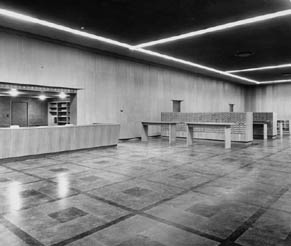
| |
The old lobby of the library (5.4.49)
|
|
Approaching the Present:
1968-1997
The next major change to Fondren came about 20 years later. Begun in 1968,
it involved adding onto the back of the library, giving room for more study space and for
the expanding collection, which was then nearing 750,000 volumes. Arguably the most
important aspect of this expansion was the creation of the Woodson Research Center,
the library's trove of rare books. The library had owned an impressive collection of
rare materials prior to the expansion, but they had to be housed in the basement, a
fact that proved tragic during the renovation. In moving the earth for the expansion,
the construction company penetrated the foundation in a number of places and then left
the holes unprotected. Then it proceeded to rain steadily for three days. The transformer
for the library was hit, so all power in the building was lost, and when the special
collections librarian came into the basement, she found over a foot of water on the
floor and more pouring in through holes in the wall. She quickly called on a number of
students, and they formed a book-passing chain as they tried to retrieve as many of
the books as possible. For weeks afterwards, drying books were set open on tables
with blowing fans. Many books were lost, but undoubtedly many were saved by the work
of the staff and students. The expansion was completed more or less without further
incident late in 1969.
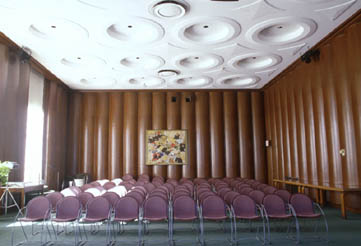
| |
Kyle Morrow Room
|
|
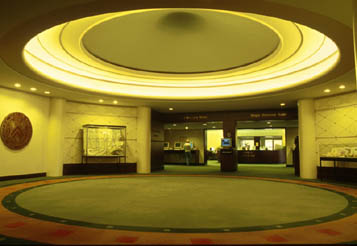
| |
Main rotunda
|
|
The most recent renovation came in 1987, which modified two or three locations
on the first floor. A current periodicals section was added, but the most noticeable
difference came in the new and radically different entrance foyer, marked with
the smaller entrance room opening out into the lovely central rotunda.
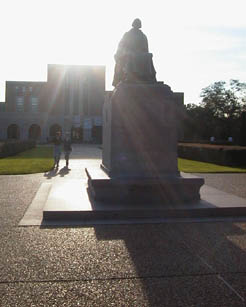
| |
Willy's statue and Fondren at sunset
|
|
Forging Ahead:
1997-
And so we come to the present renovation and expansion, which is going to
feature major additions in space and a library-wide integration of advanced technology
for better library service. The expansion and renovation will make Fondren, which now
houses 14,000 journals and 2 million volumes, one of the top research libraries in the
nation. The project was launched by the phenomenal donation of $21.4 million by
the Hobby Foundation specifically earmarked for Fondren in December of 1997. This was
the largest single donation ever given to Rice, and the renovation and expansion project
will be the largest single construction project at the university. The project is
slated to be completed in 2004, and some of the finest architecture and design firms in
the world are involved: the project architect is the firm of Shepley Bulfinch Richardson
and Abbott, and the design architect is the world-renowned Robert Venturi of Venturi,
Scott Brown and Associates. (Read more about the people and companies involved in the
construction here.) This is an exciting time for Fondren Library and, by extension,
for the entire Rice community; this change to the library will transform the
university to a degree that little else has in all of Rice's history.
|




